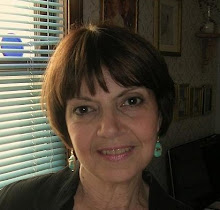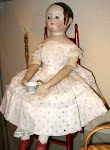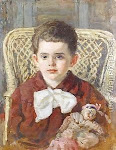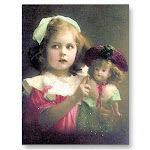

 From the late 1830s to the mid 1860s women commonly wore their hair parted in the center, looped or draped in front of the ears and neatly bunned into a low chignon at the nape. This style was modest and neat, emphasising the width rather than height of the face, and was often worn with a lace cap. Queen Victoria and Melanie Wilkes (in the 1939 Gone With the Wind film adaptation) both wore this iconically demure hairstyle.
From the late 1830s to the mid 1860s women commonly wore their hair parted in the center, looped or draped in front of the ears and neatly bunned into a low chignon at the nape. This style was modest and neat, emphasising the width rather than height of the face, and was often worn with a lace cap. Queen Victoria and Melanie Wilkes (in the 1939 Gone With the Wind film adaptation) both wore this iconically demure hairstyle.
A variation on the theme was to add a real or false braid across the top of the head, just visible in front of the cap or hat brim.


In the 1870s women wore ringlets at a ball. The hair was curled and arranged at the crown, with longer ringlets falling down the nape of the neck; often false curls would be added to the updo to increase its bulk. The front hair could be pulled straight back, parted in the center or worn as short curled bangs.

Conta & Boehme shoulder heads showing elaborate styles and hair ornament similar to plate below ca. 1860's
 "Les Modes Parisiennes" December 1865
"Les Modes Parisiennes" December 1865
 Conta & Boehme doll with hairnet holding hair in back of head ,and a golden luster tiara in the front
Conta & Boehme doll with hairnet holding hair in back of head ,and a golden luster tiara in the front
First Century Roman Woman statue shows ringlet's popularity even thousands of years ago.
 Ringlets are closely associated with many eras, the large long neck draping ringlet of Marie Antoinette's 18th Century France. The petite forehead and before-the-ear ringlets of the Federal (USA), or Regency (England) eras of early 19th Century. The ponytail full of ringlets of the Victorian era (mid 19th Century), and so on to this very day, although ringlets now usually reserved for special occasion hairstyles.
Ringlets are closely associated with many eras, the large long neck draping ringlet of Marie Antoinette's 18th Century France. The petite forehead and before-the-ear ringlets of the Federal (USA), or Regency (England) eras of early 19th Century. The ponytail full of ringlets of the Victorian era (mid 19th Century), and so on to this very day, although ringlets now usually reserved for special occasion hairstyles. .jpg)
“Pride and Prejudice” Curls
Although Jane Austen’s novel was set very late in the 1700s, the hairstyles from the BBC adaptation are appropriate for the early 19th century as well. A variation on the Queen Victoria look, this style emphasises the width of the face. The hair is center-parted and worn in bunches of ringlets at the temples, while the back hair is worn in some kind of chignon at the crown of the head.

 Alt, Beck and Gottschalck china shoulder head doll. The facial features include blue painted eyes, partially outlined in black, exposed ears and well blushed cheeks. The doll has two large molded curls on the forehead.
Alt, Beck and Gottschalck china shoulder head doll. The facial features include blue painted eyes, partially outlined in black, exposed ears and well blushed cheeks. The doll has two large molded curls on the forehead. Portrait of the Comtesse Vilain XIII and her Daughter by Jacques -Louis Davis 1816 National Gallery, London
Portrait of the Comtesse Vilain XIII and her Daughter by Jacques -Louis Davis 1816 National Gallery, London
 F.&W. Goebel half-doll with finely modelled and painted flowers on the hair. Three long vertical curls are molded on each side of the head. ca. 1900's
F.&W. Goebel half-doll with finely modelled and painted flowers on the hair. Three long vertical curls are molded on each side of the head. ca. 1900's
In the Mirror of Graces, a Lady of Distinction writes….Now, easy tresses, the shining braid, the flowing ringlet confined by the antique comb, or bodkin, give graceful specimens of the simple taste of modern beauty. Nothing can correspond more elegantly with the untrammeled drapery of our newly-adopted classic raiment than this undecorated coiffure of nature.
 "Lady in Lemon Dress"
"Lady in Lemon Dress"
During this period, the classical influence extended to hairstyles. Often masses of curls were worn over the forehead and ears, with the longer back hair drawn up into loose buns or Psyche knots influenced by Greek and Roman styles. By the later 1810s, front hair was parted in the center and worn in tight ringlets over the ears.
 "Spill Curls" ca. 1875
"Spill Curls" ca. 1875
Ringlets have been popular for thousands of years, since some woman first realized that by gently heating a rod with a candle's flame and wrapping hair around it, she might not burn her hair off, and she just might get a gentle feminine curly ringlet. Then, of course, she realized that she'd need a maid or two to maneuver around her entire head and keep a series of rods warming and at-the-ready to create a head full of ringlets.

 KPM Berlin "Morning Glory" ca. 1850 extremely rare doll, with painted eyes
KPM Berlin "Morning Glory" ca. 1850 extremely rare doll, with painted eyes  Women's styles concentrated on variations of a topknot with hair framing the face at the temples. At the beginning of the century, women abandoned their huge powdered wigs to twist their hair into Apollo knots and adorn their heads with Greek inspired wreaths, jeweled ornaments, flowers, and strands of pearls. As the century progressed, women's hair continued to be worn swept on top of the head, but the styles became more ornate. Their hair was greased, braided, and twisted into elaborate knots with curled or frizzed hair at the sides. Women's hairstyles had become so elaborate by the end of the century that wigs were back in demand. These elaborate styles provided many poor women with needed money, as they cut their hair and sold it to wigmakers.
Women's styles concentrated on variations of a topknot with hair framing the face at the temples. At the beginning of the century, women abandoned their huge powdered wigs to twist their hair into Apollo knots and adorn their heads with Greek inspired wreaths, jeweled ornaments, flowers, and strands of pearls. As the century progressed, women's hair continued to be worn swept on top of the head, but the styles became more ornate. Their hair was greased, braided, and twisted into elaborate knots with curled or frizzed hair at the sides. Women's hairstyles had become so elaborate by the end of the century that wigs were back in demand. These elaborate styles provided many poor women with needed money, as they cut their hair and sold it to wigmakers.
 Millinery shop in Paris, Chalon ca. 1822
Millinery shop in Paris, Chalon ca. 1822Artist Rolinda Sharples wears her hair in a mass of curls; her mother wears a sheer indoor cap,
The most widely used hair preparations of the century were Macassar oil and brilliantine, whose functions were to give hair shine. In general, hair fashions changed faster as news traveled faster from one country, and even continent, to another. The simplicity of the smooth, center-parted styles worn by women in the Victorian era lasted until the 1870s, when the Parisian hairdresser Marcel Grateau created a new, natural-looking wave by turning a curling iron upside down. The Marcel wave remained popular for almost half a century and helped usher in a new era of women's waved and curled hairpieces, which were mixed with the natural hair. Another major innovation at the end of the 19th century was the invention in 1895 of the safety razor by an American, William Gillette. Barbers now concentrated on cutting hair and trimming beards and mustaches, and a new age of at-home grooming practices began.













































.jpg)
































































































 "A Night at the Opera" Margaret Whitton Collection ca. 1840
"A Night at the Opera" Margaret Whitton Collection ca. 1840














